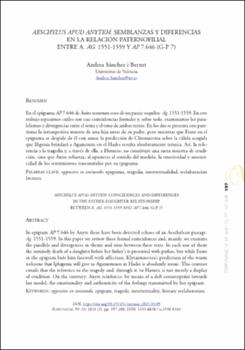Aeschylus apud Anytem. Semblanzas y diferencias en la relación paternofilialentre A. Ag. 1551-1559 y AP 7.646 (G-P 7)
Autor
Sánchez i Bernet, AndreaFecha
2021Resumen
En elepigrama AP 7.646 de Ániteresuenan ecos de un pasajeesquíleo: Ag. 1551-1559. En este
trabajo repasamos cuáles son esas coincidencias formales y, sobre todo, examinamos los paralelismos y divergenciasentreel tema y el tono de ambos textos. En los dos se presenta con patetismo la intempestiva muerte de una hija antes de su padre, pero mientras que Erato en el
epigrama se despide de él con amor, la predicción de Clitemnestra sobre la cálida acogida
que Ifigenia brindará a Agamenón en el Hades resulta absolutamente irónica. Así, la referencia a la tragedia y, a través de ella, a Homero, no constituye una mera muestra de erudición, sino que Ánite refuerza, al oponerse al sentido del modelo, la emotividad y autenticidad de los sentimientos transmitidos por su epigrama. In epigram AP 7.646 by Anyte there have been detected echoes of an Aeschylean passage:
Ag. 1551-1559. In this paper we review these formal coincidences and, mainly, we examine
the parallels and divergences in theme and tone between these texts. In each one of them
the untimely death of a daughter before her father's is presented with pathos, but while Erato
in the epigram bids him farewell with affection, Klytaimnestra’s prediction of the warm
welcome that Iphigenia will give to Agamemnon in Hades is absolutely ironic. This contrast
entails that the reference to the tragedy and, through it, to Homer, is not merely a display
of erudition. On the contrary: Anyte reinforces, by means of a deft counterpoint towards
her model, the emotionality and authenticity of the feelings transmitted by her epigram.





